My goal is to see birds as garden teammates — as they eat insects that can be pests, such as aphids — and not as enemies as they peck the fruit on my trees. As far as my experience goes, the best way to accomplish this is to prevent birds from access to the fruit.
I’ve found two forms of protection to work well: bagging and netting.
Bagging
If a fruit tree is large or if there isn’t too much fruit on a tree, then bagging individual fruit or small clusters of fruit is effective and economical.
I’ve used mesh produce bags, like this one from Earthwise that is protecting a bunch of grapes:
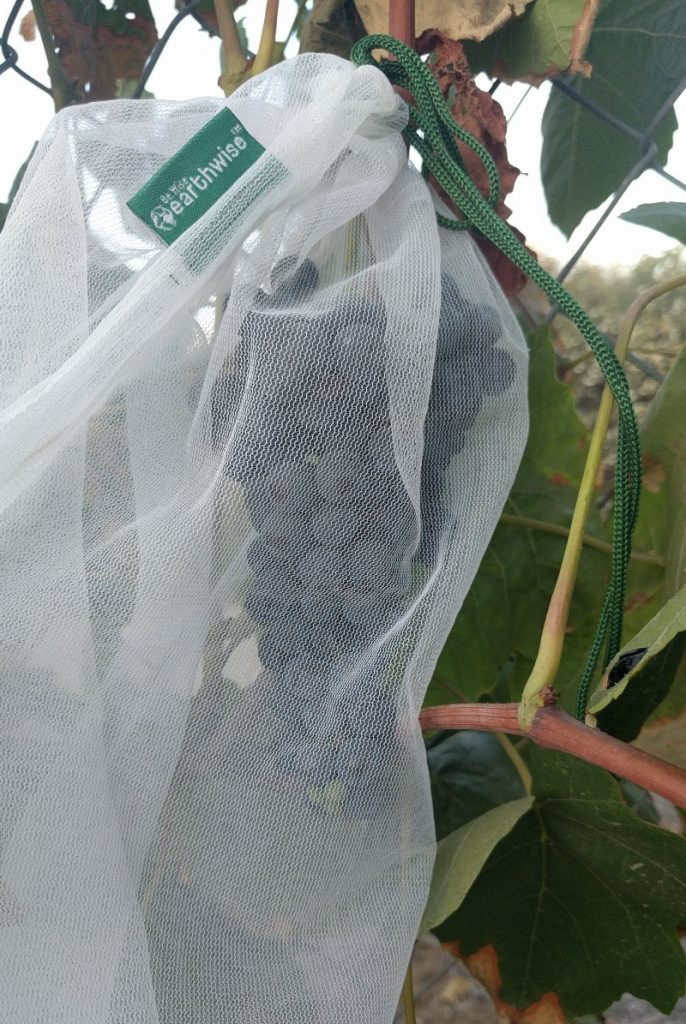
Here is a cluster of pluots that I protected with one mesh bag:
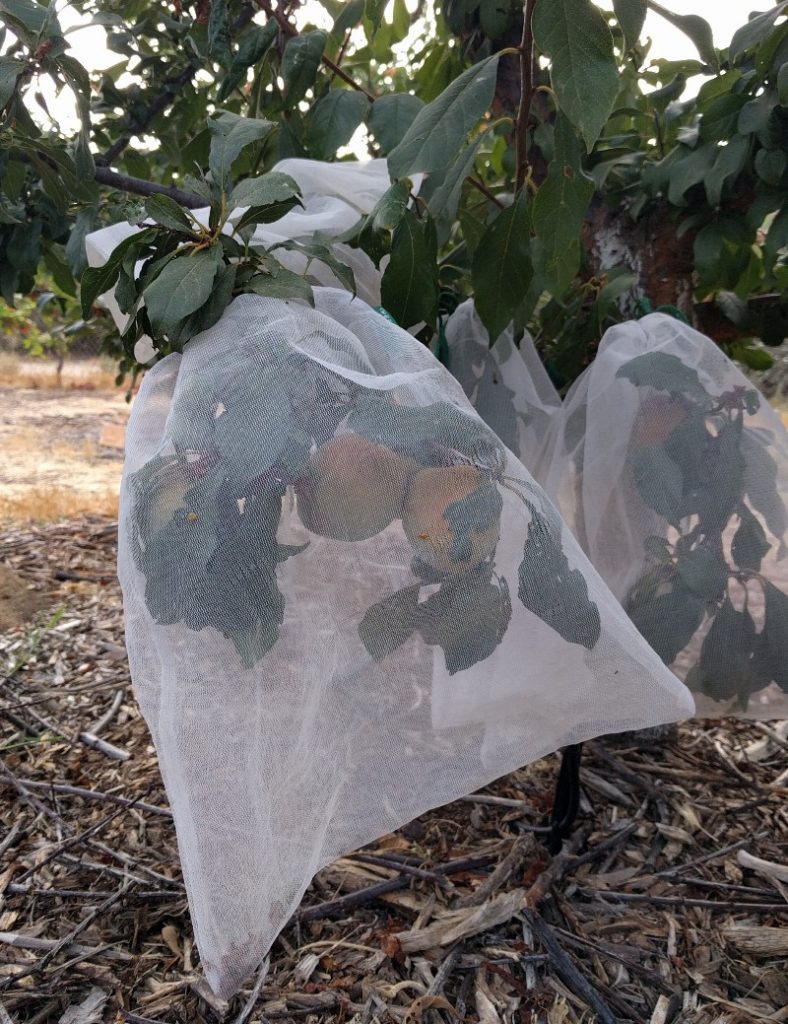
I’ve also “bagged” fruit using swatches of breathable fabric held together with clothespins. Here are a couple peaches protected like that:

Netting
The other effective protection I’ve used is netting, but I’ve never used the nets that are actually sold for that purpose. Those nets have mesh so large that the net gets snagged on the ends of branches too easily. And if you leave the nets on, branches will grow through them.
I like to use tulle fabric. Specifically, I buy “Economy Colored Polyester Tulle in Bolts” from Papermart, and I buy a bolt 108 inches wide by 50 yards long, which costs around $35. (It cost $10 when I last bought one in 2018, which I’m still using here in 2024.) This bolt has enough fabric to protect the fruit of dozens of trees.
Sometimes I just wrap branches or sections of trees, like this Blenheim apricot:
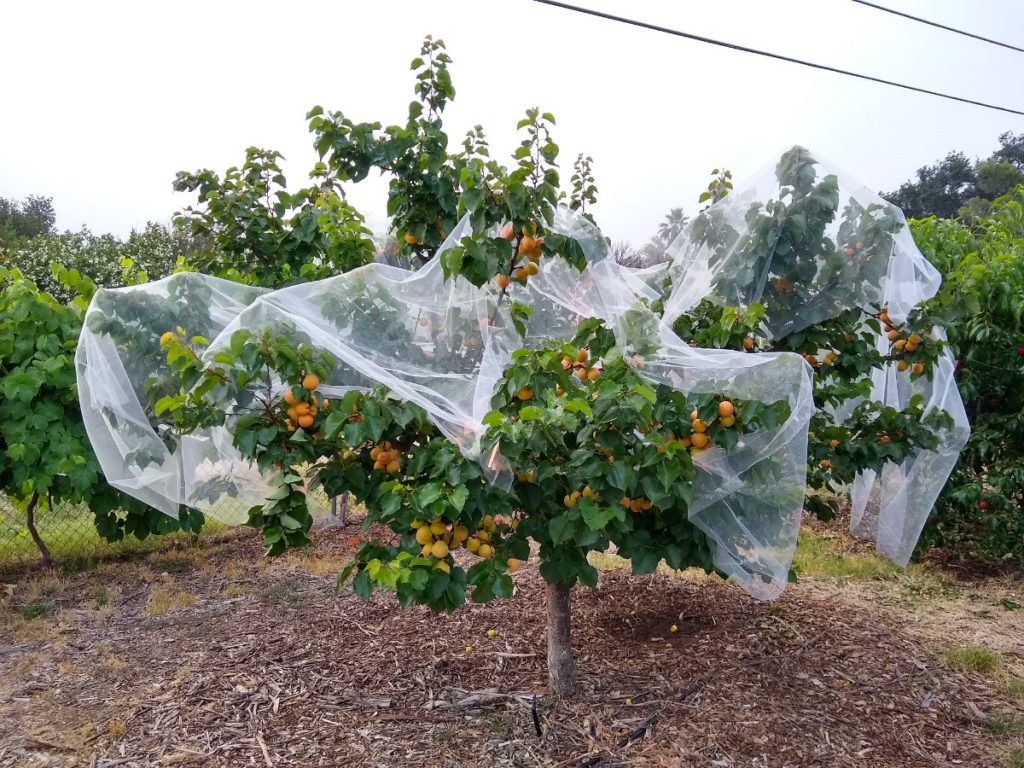
Obviously, some fruit is still vulnerable to bird pecking so I do this only if the crop is huge and I don’t mind losing some.
Otherwise, I wrap the entire tree. It’s helpful to trim branches that are sticking out farther than the rest of the canopy before applying the net or else you can let those branches stick through the seams.
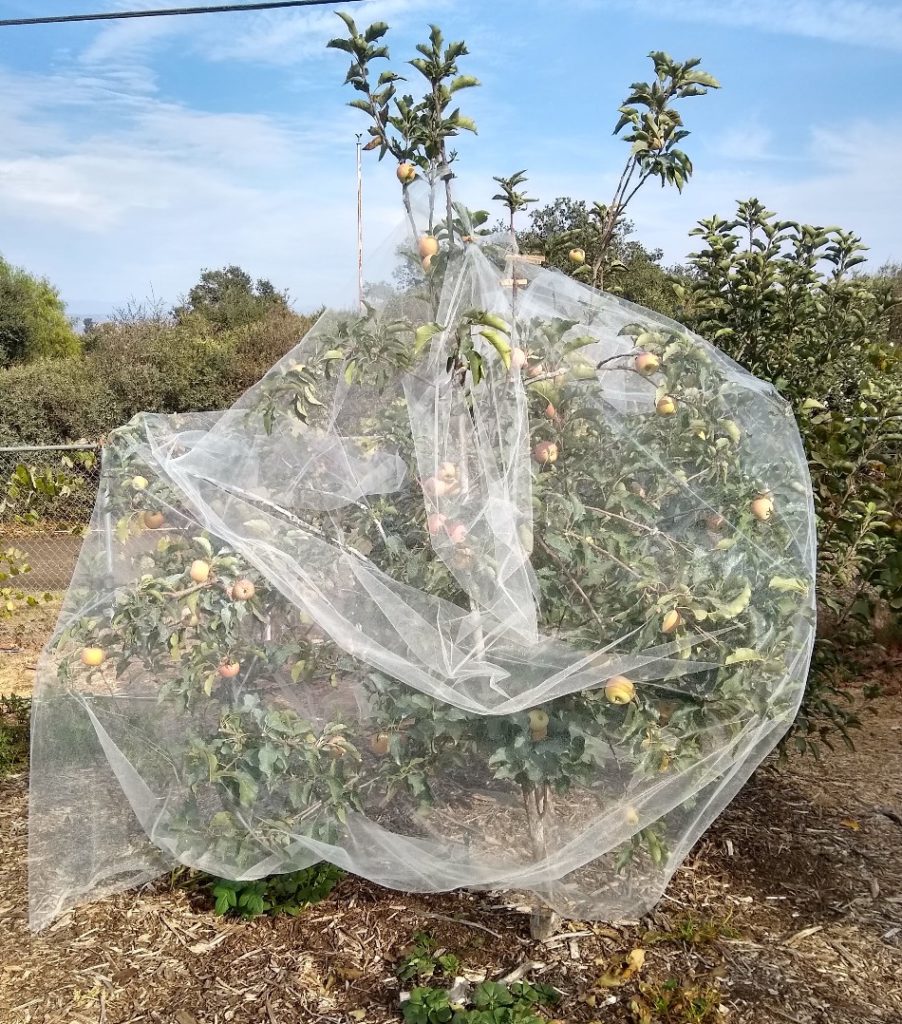
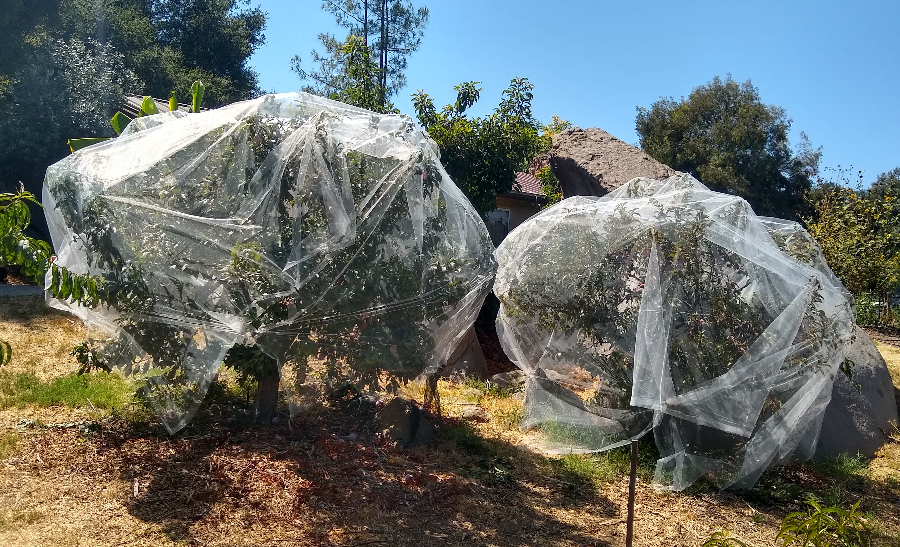
I do the same with blueberry bushes:
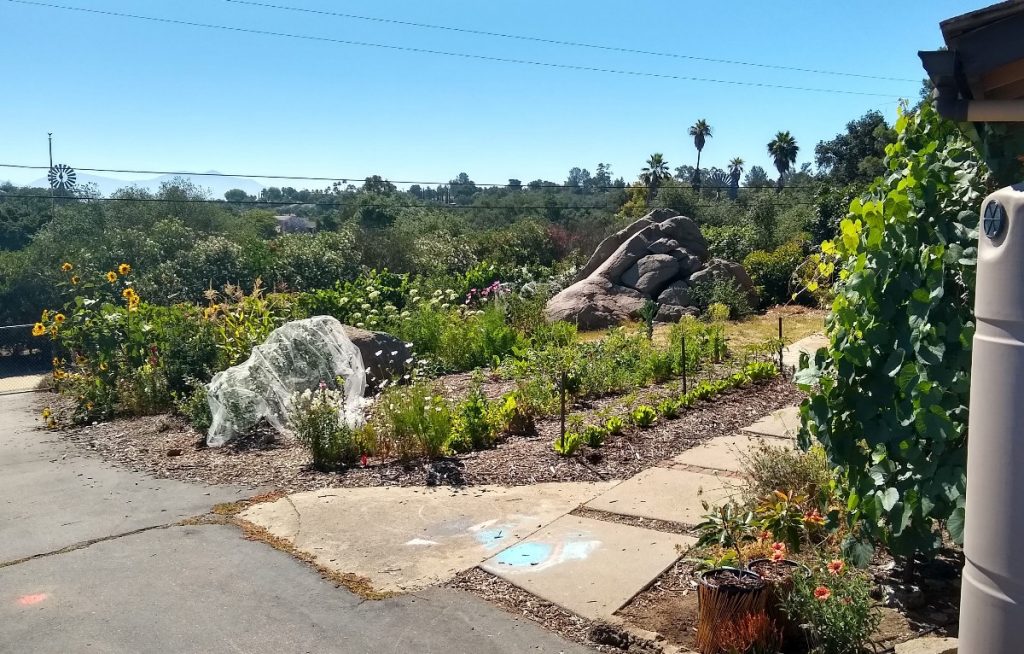
I use rocks to hold down the tulle fabric around the blueberry bushes whereas I fasten the tulle fabric around branches or whole trees with clothespins. It’s easy to poke your arm into the seams of this tulle wrap in order to harvest fruit without having to remove the netting.
While you do want a net to be generally closed around a tree, it’s still effective if there are small openings remaining, up to about six inches wide. One type of bird that pecks at fruit in my yard is the small finch, but I’ve found that even finches rarely enter gaps in the net of that size.
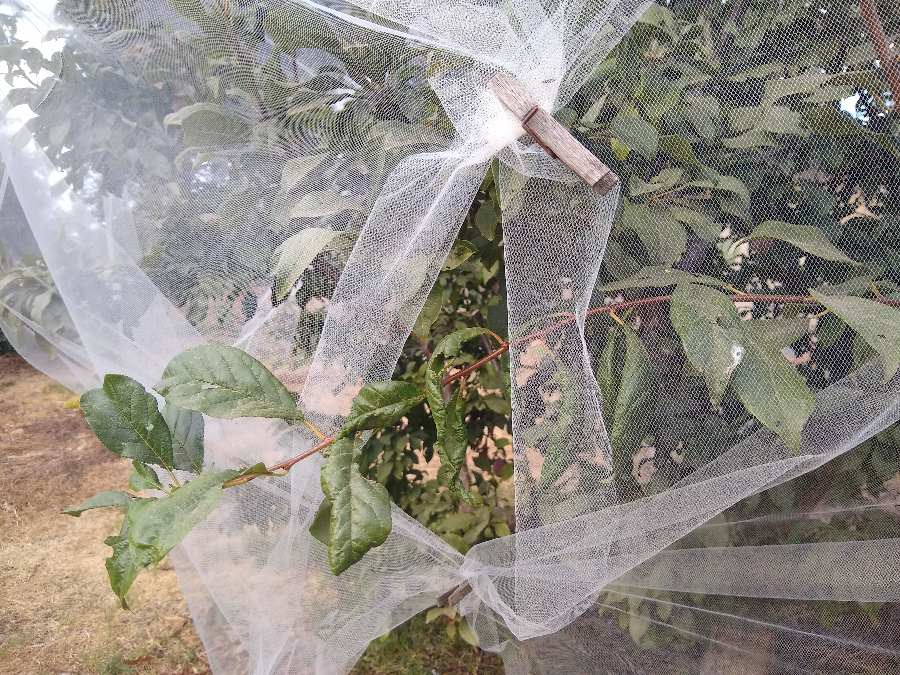
(I use the same tulle fabric to protect my vegetables from rabbits. See “Protecting vegetables and fruit trees from rabbits.”)
Grapes
Both bagging and netting work to prevent birds from damaging grapes. I switch to netting if I’ve got many bunches to protect. As with trees, bring a pruning tool to the grapes so you can clip back shoots that protrude before you begin netting.
My favorite net for grapes where both sides of the vine are accessible is a “side” or “zone” net. It’s one that many vineyards use, and it’s 3-4 feet wide and can be hundreds of feet long. The net is fastened to each side of the grapevine using clips at the top and bottom.
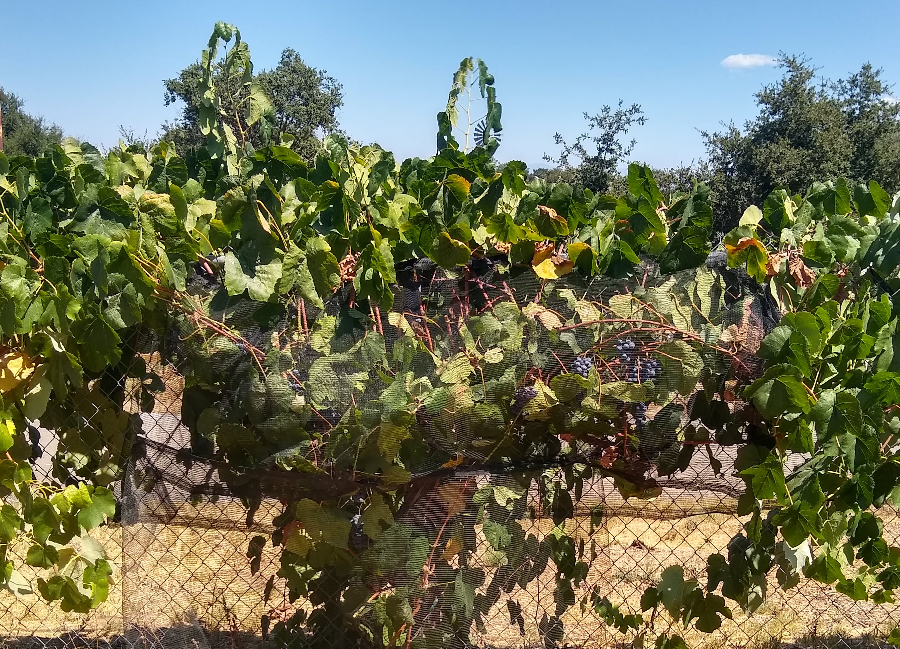
The challenge is where to buy this netting, especially in shorter lengths appropriate for a backyard grower with only a vine or two. I can’t find such a source. (Let me know if you can.) A neighbor with a vineyard kindly shared some with me a few years ago. Maybe you can visit a local vineyard and offer to buy a few feet of their old netting.
Alternatively, you can prune down the top shoots of your grapevine and throw a net designed for a fruit tree over the whole plant. Some vineyards also use such nets draped over the tops of their vines.
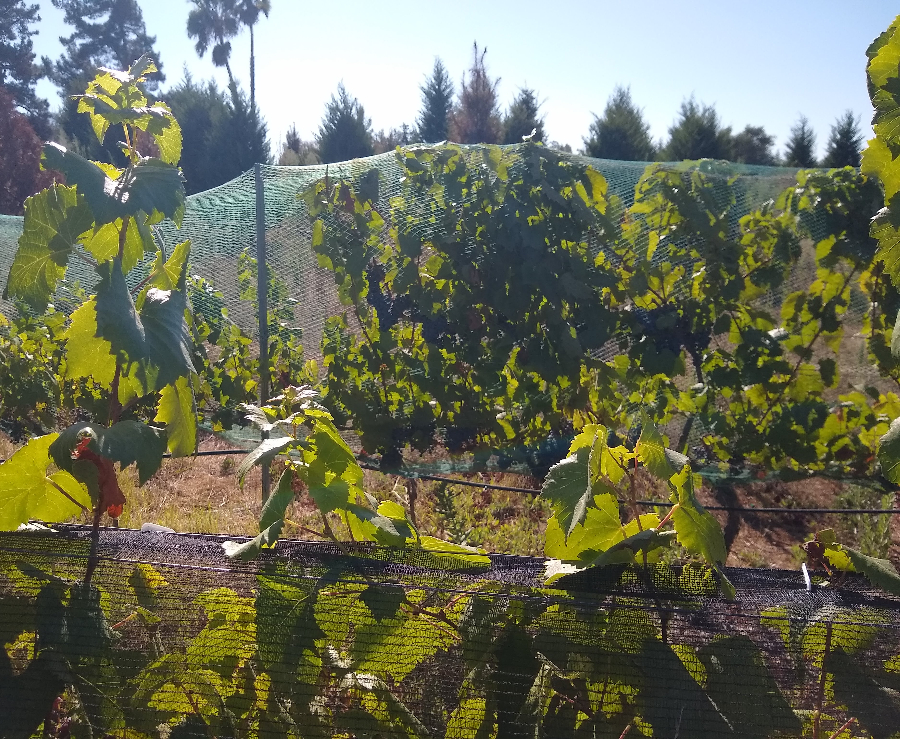
I prefer the side netting because it doesn’t require trimming the tops of vines.
Reflective strips?
One thing that I haven’t found effective is hanging reflective strips in a tree. When I did this in a Fuji apple tree the birds continued to peck the fruit at the same rate as before.
Another kind of bird I’ve got pecking my fruit is the scrub jay. Scrub jays are smart. I can’t imagine them having been deterred by a reflective strip for more than twenty seconds.
Other pests
Finally, while the bags and nets have proven very effective at keeping birds from pecking the fruit of my trees and grapevines and blueberry bushes, these nets do not stop certain other critters. Rats and possums and squirrels will chew right through these bird barriers and then consume the fruit. You’ve got to deal with competition from those animals in other ways.
Here’s how I deal with squirrels. Here’s how I deal with rats. And here’s how some other food gardeners in Southern California deal with squirrels and rats.
Thanks to everyone who generously supports my Yard Posts so I can keep them coming and keep the ads away.
All of my Yard Posts are listed HERE




I tried the mesh over my little tress. Was 100% not worth the trouble and I don’t think it saved a single fruit. The thin plastic mesh got caught on all the new little branches and then eventually new growth grew through the mesh making it nearly impossible to remove once fruit was gone. My only hope is that once my trees are mature and set loads of fruit I will not be so disappointed at sharing a few fruits with the birds.
Birds are not so much the problem. And I agree with you, spreading netting all over my 40 various trees is a joke. Birds get in, after the squirrels chew thru the netting. I’m more interested in keeping squirrels out of my yard. They devour 50% + of all my Fruit, Citrus, & Avocado trees. And especially my Fig trees…& Guava trees fruit right Now.
Is there something we can do to prevent racoons and coyotes from eating persimmons. I have already lost half my fruit!
I cover my blueberry bushes with tulle. It works great to keep the birds from eating the berries.
Thank you so much for sharing that, Jennifer. I hadn’t known the name of that material as tulle, but that seems to be the ideal size of netting for the purpose of excluding birds. I just bought some and I’m going to experiment with using it to protect my late season apples (and maybe next year’s blueberries).
This is such a timely post Greg! Thank you! I bought some bags on Amazon and they came overnight! I covered all my nectaplums, peaches and plums. My problem want birds, it was Japanese Beetles. They were swarming the fruit! Now they are gone! Thank you!!
Hi Renee,
So glad to hear they worked for beetles too. So glad to hear that.
Have you had any experience with wrapping large fig trees? What do you suggest?
I used to think that I needed three times as much fruit on the tree as I could actually eat (some for me, some for the birds and bugs, and some to fall on the ground). I’m pretty sure I need to up that to four times as much as I need after seeing what the birds and bugs can do. As for the Japanese beetles; we’ve had the fewest this year of any year and I’m pretty certain it’s because our chickens free range our whole back yard and eat up all the grubs.
I’ve been wondering the same thing about chickens and green fruit beetles and other insect pests. We have very few of them, and I too suspect it’s because of the chickens’ roaming under the trees and eating grubs throughout the year.
Reflective tape and old stuffed animals has worked for me this year for my blenheim apricots and any fruit that ripened before that (cherries, early peaches etc). Not sure why. Doesn’t work anymore though, birds pecked holes in half my persimmons over this heat wave. Had to net the rest.
Old stuffed animals? Peter, does your daughter know about this?
I notice these strange patterns too, where at times something seems to work but later it doesn’t, or it doesn’t on a different tree. For me this year, my cherries were so hard to keep birds off. They were even pecking and tearing the tulle fabric to get to the fruit. But a couple months later I didn’t even net my peaches and had barely any pecking. And right now I’ve got tulle over my pluots and it’s working 100%. Guess we have to remain flexible.
My daughter sent me an assortment of mesh bags to use on my fruit. I have fig beetles that attack my tomatoes peaches and figs. I put a bag over some figs, but I did not seal it completely and they found a way in, so I had a bag of beetles. A little Sevin spray and they were history, but of course the figs were history also. I tried again, but the rats chewed a hole in the bag and stole the figs. The rats go crazy for the Cherimoyas too, so there was no sense in putting a mesh bag on them. Next year I’m going to try aluminum window screen in the size of the large fruit and see if the rats won’t bother with it, although I know they can chew through aluminum mesh. I have a couple of other ideas I’ll share after I try them. The bags keep out the bugs, but not the rats.
Hi Richard,
Good point. I don’t have rats that cause problems, but a possum did chew into a couple mesh bags on my peach tree last summer. The bags keep out the birds, but not the possums.
Was just wondering if Pi tens would work the same they’re not my fruit trees I’m just taking care of them
Hi Marvin,
Not sure. I’ve never tried pie tins, but I do know that most scare tactics like that only tend to work for a short while — maybe they’ll work long enough to save some harvest though.
How about the solar sonar things?
What about the semi-transparent white cloth used for frost Protection in the spring? Is that too heavy for summer? Does it let everything ripen?
I have the same question… protects really well but I wonder if the berries ae getting enough sun to ripen properly!?
It seems that if birds see the fruit that they will just peck thru the mesh. Do you find this not to be the case?
Hi Norm,
Yes, I’ve seen this happen. The mesh really only protects the fruit that is deeper inside of the canopy.
New to Apple trees here. Does sun need to get in? I have linen bags but they are more opaque than the tulle but some light will get in.
Hi Geri,
Sun doesn’t need to get in, but if it doesn’t then the apples won’t color in the same way as they do in the sun.
netting has not worked well for me at all, mocking birds found a three inch gap in my cherry tree netting and went to town, finches actually forced their way in through an overlap in the netting of my plum tree, and squirrels crawled my entire almond tree and found every gap, but then chewed their way out a different location by the trunk. I think if I would have a perfect seal, it may work. I’m not sure if the squirrels would actually chew through the netting to get in, but I have yet to get a 100% seal on my netting. The tree is a bit large and I have to use several joins or overlaps, so i’m not sure what to do.
Hi Jeff,
Bummer to hear this. What kind of netting have you been using? What have you used to close the overlaps?
Hi Greg,
I use this one, from Amazon:
Bird-X Standard Bird Netting, Ideal for Gardens and Lightweight Applications, UV-Stabilized Mesh Netting with 3/4″ Hole Opening, Easy to Install, 100′ x 14′ ( I think it’s the stuff they use to cover grapes ) and painstakingly tie it up with that green soft wire tie for plants to close the overlaps, although I try to put one every few inches, but they always seem to find a section where it’s large enough to squeeze in ( the almond tree is almost 10 feet tall with a similar diameter, so it’s pretty tough to get every spot ). The plastic mesh is really strong, it takes the squirrels more than a few minutes to chew through it.
I was considering using hardware cloth to build a box/frame around it, but after reading that most of it contains lead, I was hesitant.
For the birds I would just need more overlap, and to make sure there are absolutely no openings, but for squirrels, other than trying to eliminate them, i’m running out of ideas. Although I will say, I haven’t seen them biting to get in, only out, so if I had a perfect seal with no openings, I can’t say it wouldn’t work, but I just haven’t been able to achieve that.
The squirrels also seem way more interested in the almond tree than anything else (cherry, apple, persimmon, fig, loquat), it’s interesting to watch how long they will work on trying to get in through the netting, 20 to 30 minutes at a time. I have a camera so I can see where they got in, I fix it, patch it up, and the next day the cycle repeats 🙂
Hi Jeff,
With your camera do you also see where the birds are getting in? Is it just in the small gaps? Is it high in the canopy or down near the ground?
The camera only gets the almond tree, but the mocking birds got in to the cherry netting through a small hole that was pretty high up in the canopy. The finch that got in to the plum tree netting was also high up, I have a pvc frame, and tied the netting to it so it wasn’t touching the tree too much, and so I had a wine glass shape from the trunk up to the top of the pvc box, then placed another piece of netting over the top of the pvc box to close it in. Somehow, it forced its way in through that overlap. I was watching it for several minutes chaotically trying to get out while I stood there, but it didn’t get out, I went to get my ladder to actually open it, so it could get out, but by the time I got back with the ladder, it somehow found its way out. I found it really strange because there was no obvious hole anywhere, just overlaps, so some how it pushed it’s way through the overlap. I actually was worried when I put the netting up that the birds may get caught in it, because it sticks to everything, but they seem to navigate it with ease.
I like to use the mesh produce bags, but can only hang them on the avocados I can reach. So I risk sacrificing some of the fruit that I can’t get to way up high. Couple months back you wrote of covering the fruit with paper plates to repel squirrels. I tried that (again on the lower fruit) and it’s worked, in fact I think it has repelled the squirrels from the tree, as I see them in the yard, but no evidence of them in the trees or fruit. The birds liked the paper plate canopies at first- I think they though maybe it was a feeder, or something to land upon.
Another note, the paper plate covered fruit is 1.5 x large as the rest of the fruit up high. I know they could’ve been the first pollinated flowers, but they are quite consistent in this group
Hi Kathryn,
This is very interesting. Thanks for the report! It just occurred to me that the paper plates can also serve as sun protection, which might help fruit enlarge too. I’m going to try some paper plates on Pink Lady apples on my tree and see what happens.
Thanks for the article. I only tried netting once a few years ago on a blueberry bush. I used the store bought netting & a mockingbird got caught in the net. I was able to free it & decided not to use nets again. Saving the bird was more important to me than saving the blueberries. But the tulle with the tiny holes might be useful and also the recyclable mesh bags, so thanks again. I have two orange trees and the rats get to those, but there is always enough fruit to share. I just don’t like cleaning up the empty husks left under the tree!
I have the same issue with a larger orange tree ( usually 200+ oranges ), the rats only eat a few per season, but for the first time in 2022, i had 4 big possums in my yard, and they each ate an orange every night, that got me worried, because they also like to do similar with the avocados (which I don’t have that many of). But strangely, in 2023/2024 they are not eating the oranges, i’m not sure why just that one year, but i’m glad, and hope they don’t make a habbit of that. They still take the avocados, but I think I only have 1 possum currently, and I have all kind of bite marks on the avocados, not sure if it’s rat or possum bites, but the avocado tree is far to big to try to cover.
Last year, I planted my first avocado tree. I was thrilled when I got six full sized avocados, but I came back from a short vacation and two were missing. I didn’t want to use anything poisonous or harmful to wildlife, so I opted to make little tin foil “hats” for my avocados and it totally worked! The birds and squirrels seems to ignore the avocados completely!
Too bad we can’t post images, but we lost almost all our crop of loquats last year to birds, rats and squirrels. The first time this happened to this magnitude. In spite of the trapping and other methods of removing the rats and squirrels. This year we completely netted the loquat, wrapped the trunk and tucked it tight with clothespins. The tree is 10 feet maybe a bit more, reduced in height to manage easily. Anyway, this year we had ALL the fruit to ourselves, enough to eat and purée to freeze.
Our new 3-in-1 apples and stone fruit trees got pvc frames with netting attached to the frames, again secured with clothespins. They stayed open until the bees finished pollination, then buttoned up. Again, all the fruit has been untouched and ours to enjoy. Later we’ll remove the nets to allow the trees to continue their year.
A lot of work, but the effort was worth it with how much fruit remained undamaged and ours to enjoy.
My challenge is not only the birds, but the squirrels.I used full tree nets with zipper and draw strings this year for the first time and had great success. I bagged my read Avocado nectarine and plum trees and they handled the bags very well. Thanks for a great post Greg.
What do you do about fig eater beetles?
In Tucson, I’ve struggled with hungry critters for years. I’ve used bird netting, but verdins and goldfinches can squeeze through 1/2×5/8 inch mesh (it was sold as 1/2×1/2) and lizards and snakes get stuck in the mesh and die. 1/4″ netting worked great, but wasn’t UV stable and only lasted a year. Neither style of bird netting worked against pack rats and ground squirrels. Covering branches with sleeves sewn from old sheer curtain material worked well until woodpeckers made holes in them. I’ve covered individual fruits with plastic berry boxes and covers I made from 1-liter plastic bottles, and they work but are too labor intensive. I finally built a couple of walk-in orchard cages (25’x25’x11′ high and 75’x25’x11′ high) from light-gauge 1/2″x1/2″ PVC-coated, galvanized welded wire, and they’ve kept all larger pests out, including birds, rodents (except for a few mice, which I trap), and fig eater beetles. Honeybees can go through the mesh, but unfortunately so can driedfruit beetles, ants, aphids, and scale.